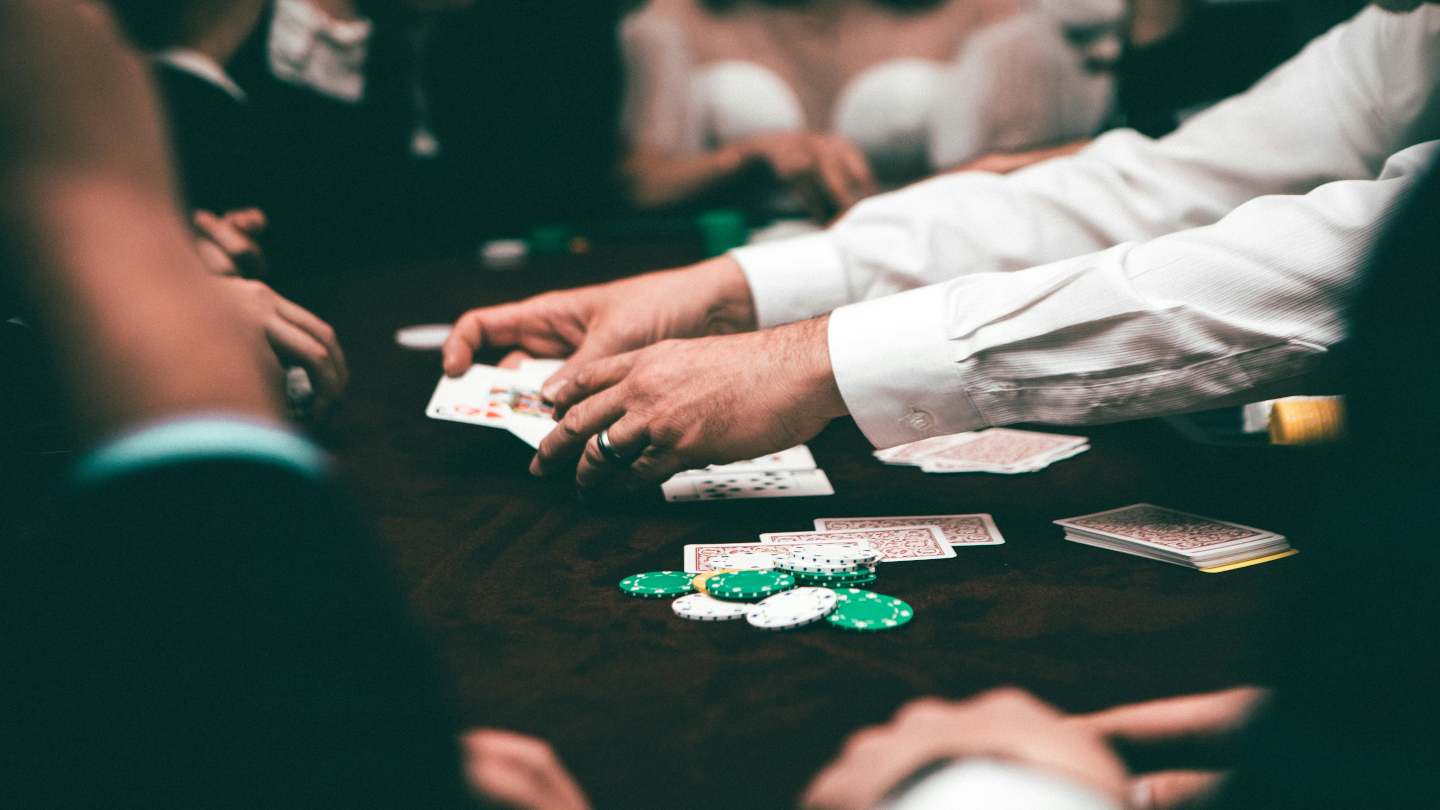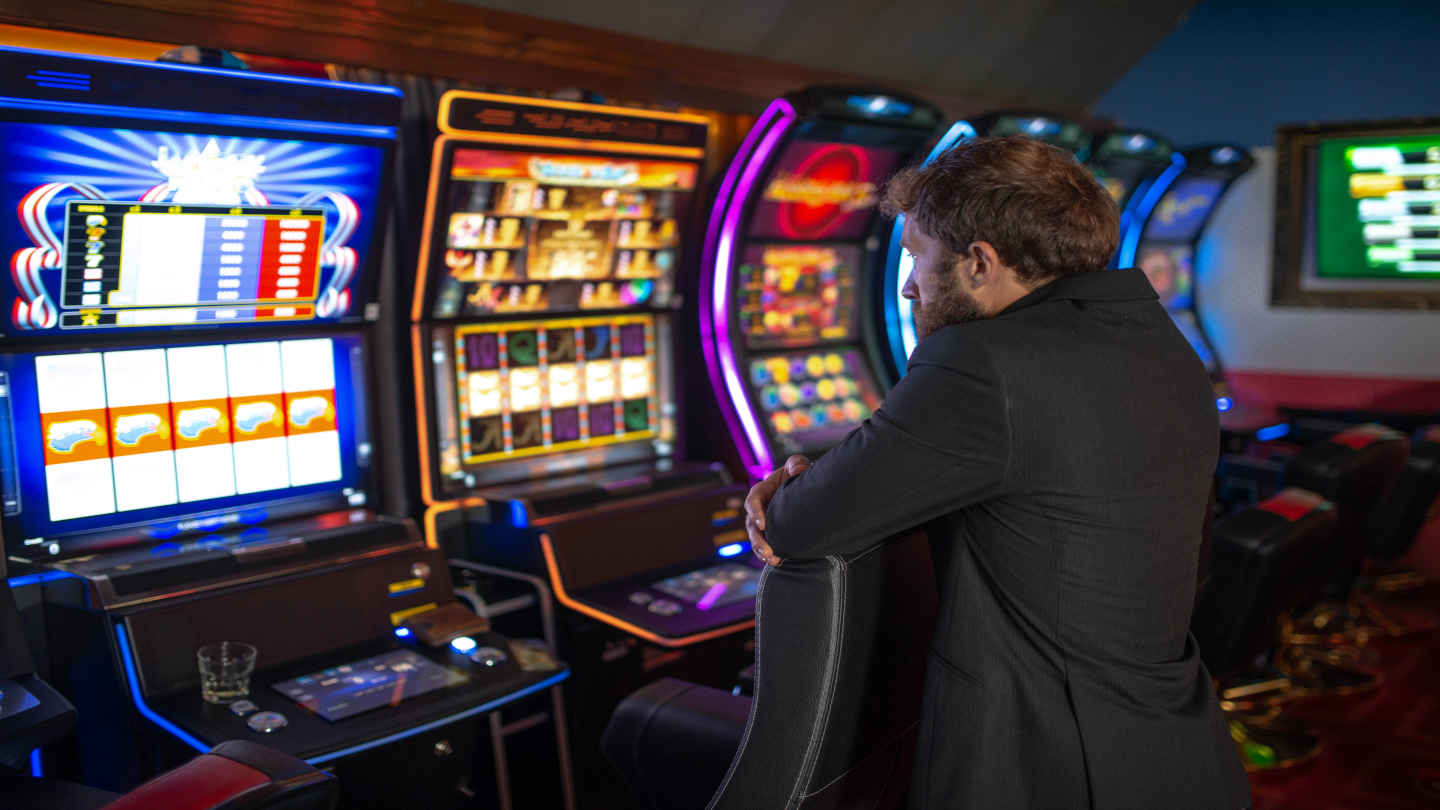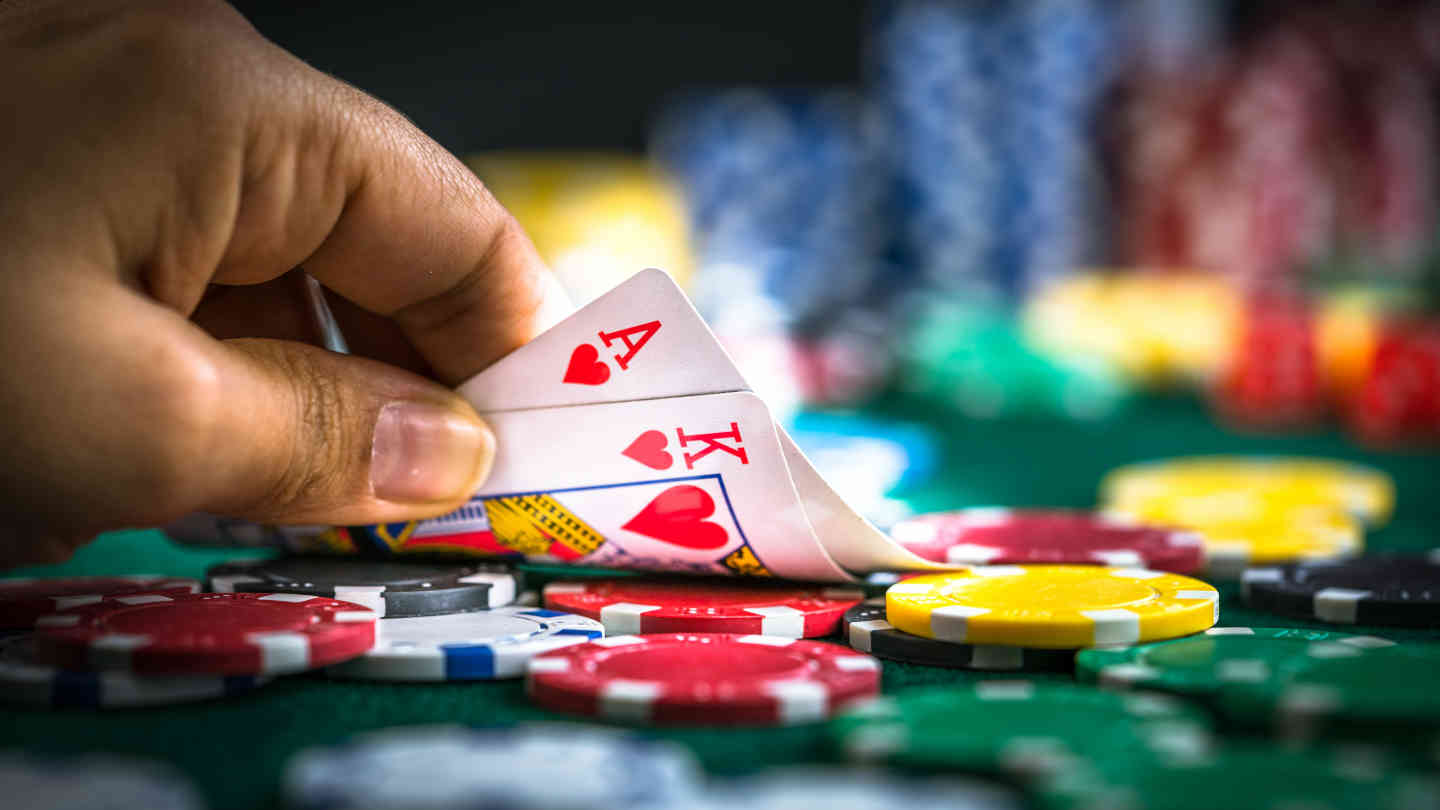Poker Positions: How to Make Your Opponents Cry

16 minutes
The one indisputable fact about poker is that most people think they are great at it. The fact, of course, is that most people play poker quite poorly simply because they have never really taken the time to learn the game.
Among the amateur players, one of the most underrated elements of the game is certainly the concept of position. Bad players tend to just play their cards and completely ignore their position.
In this article, I take a look at the concept of position and how positional advantage can help you win more in poker and make your opponents squirm in their seats.
I will teach you what position is in Texas Hold’em and how to use it to your advantage, as well as go over all the possible positions you could find yourself in, and give you some tips on how to play them.
Let’s start out by explaining the concept of poker position in the most basic of terms and what it actually means in the game.
What is Position in Poker?
When you hear the word position, you might jump to a conclusion and think about the seat someone has at the table. In fact, many amateurs believe in the concept of lucky seats and tend to change their “position” in hopes of winning more in another seat.
In reality, your physical position at the table will do little to help you win or lose in the long run, as good and bad cards alike will be dealt to any player regardless of where they sit.
Instead, when we talk about position in poker, we are talking about one’s relative position in comparison to the dealer button, the blind bets, and other players at the table.
This means your position will change from hand to hand, and you will end up having to play in each of the possible positions, with players taking their turns at different ones.
Position is critical in every form of poker, but big bet games like Texas Hold’em and Pot-Limit Omaha make it even more important to play a good positional game.
The one main thing that position determines is who goes first on various betting streets. If this seems trivial to you, you may want to think again.
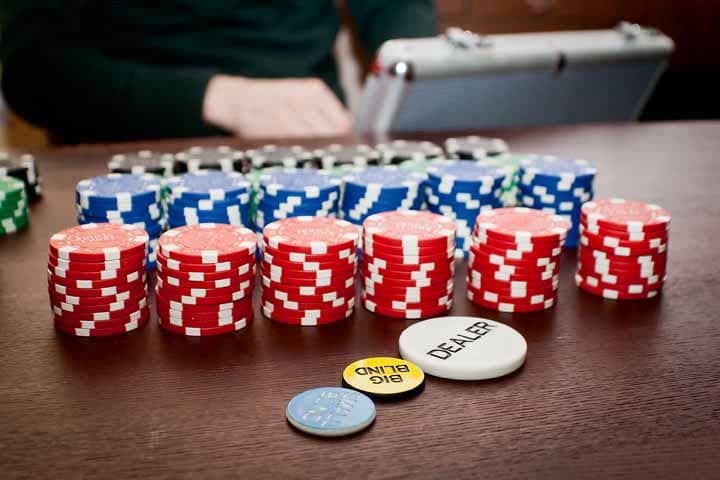
Think about seeing the flop, turn, and river and having to bet or check first as opposed to seeing what your opponents do first and acting accordingly.
Quite clearly, acting last on betting streets is favorable and gives you more options to get value, bluff, trap, and get out of danger cheaply.
In Position v Out Of Position in Poker
When watching the various TV poker broadcasts, you have surely heard the commentators say how a player is in position or out of position during a hand and perhaps you didn’t know what they meant.
Being in position means being last to act on a particular betting street. Conversely, being out of position means having to act first on a betting street.
In Texas Hold’em, the player sitting in the small blind will always be out of position on all post-flop betting streets, while the player sitting on the dealer button will always be in position against all other players.
All other positions may end up being in or out of position, depending on what other players end up seeing the flop.
Depending on their absolute position at the table, players should play fewer or more hands before the flop. The players in good positions should be looking to play more hands, while those in bad positions should look to get out of harm’s way whenever possible.
Importance of Poker Positions for Over / Under-realizing Your Equity
In every poker hand, no matter what cards you are holding, you will have some equity against your opponents. You can look at equity as your chances to win the pot.
Of course, the odds that you will see on TV or if you run a hand through a simulator are only those that will be realized if the hand gets to showdown.
As we well know, most poker hands end before the showdown, with someone making a bet and other players folding either on the flop, turn, or river.
This is exactly what makes the position so important. Players in position get to over realize their equity, while those out of position, unfortunately, under realize theirs.
Let’s say two players are in a hand, and they both have exactly 50% equity pre-flop. However, one of these players is sitting in the small blind, and the other is sitting on the button.
If the hand was played many times and went to showdown, these players would each win their fair share of the pots, 50% in total.
However, since there is betting yet to come, the player in position will have a significant advantage. He will get to see his opponent’s actions and make smarter and more deliberate plays.

Once the flop hits, the small blind player will be forced to check or bet without getting any extra info from his opponent. The dealer, however, will get to see what the small blind did and make a more educated play based on that.
If the dealer raised before the flop and the small blind called, the small blind will have to check on most flops. The dealer can then decide whether he wants to bet for value, bluff, or see another card completely free.
When all is said and done, the dealer will realize more than his fair 50% of equity, while the small blind will be bluffed out more often and also pay off value bets more often, realizing less than his 50%.
The best players in the world are able to reduce their losses when out of position, but not a single player out there can boast about winning more when out of position than in position.
Poker Positions Explained in Detail
So now that we know what a position in poker is, let’s talk about the various poker positions you could find yourself in at the tables.
First of all, it’s important to remember that Texas Hold’em table can be 6, 7, 8, 9, or even 10 handed. Depending on that, there can be more or fewer positions at the particular table.
Regardless of the number of players, poker positions can be categorized as early, middle and late. Of course, the more players at the table, the more of each there are.
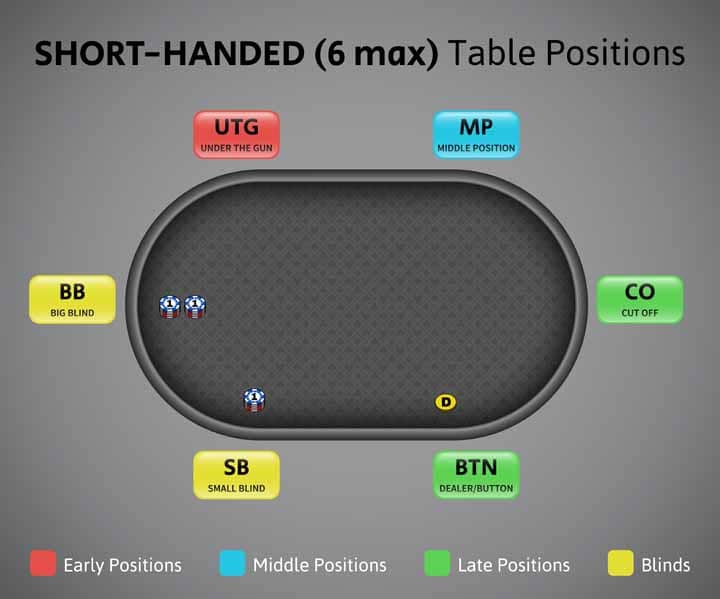
As you probably guessed, early positions are less favorable, while late ones are more favorable. I will go through positions at a classic 6 handed table now, explaining how you may want to adjust your play in each.
The Small Blind (SB)
The least favorable of all positions at a poker table, the small blind is dreaded by most serious poker players.
The player in the small blind is forced to put some money into the pot, does not even close the action pre-flop, and will always go first after the flop.

For that reason, it is important to choose the hands you play in the small blind very carefully. Of course, since you already have money in the pot, the immediate odds you are getting can seem tempting at times.
However, even when folded to, you should consider folding many hands, simply because you will never get to realize your equity in full.
When you do decide to play hands, you should be playing aggressively and raising whenever possible, trying to win as many pots before the flop as you can, thus avoiding having to play out of position on later streets.
The Big Blind (BB)
The big blind is an interesting poker position because it forces the player to put the full forced bet in. When no one raises, the player in the big blind can simply check and see the flop.
This is exactly what makes playing in the big blind so tricky. Even when players make small raises (which are the norm these days), the big blind gets amazing odds to make a call.
However, the big blind will be out of position against all players apart from the small blind, which means caution is advised.
When playing in the big blind, you should look to defend a wide range of hands against small raises. Calling with most of these hands is the preferred choice since the immediate odds are good enough.

Playing in the big blind, you should look to re-raise only with your strong hands and enough bluff hands to balance out your range. Poker hands like A2s – A5s are great candidates to re-raise from the big blind.
Under The Gun (UTG)
Under the gun means sitting directly to the left of the big blind. The player in the UTG position plays first before the flop and goes after the blinds once the flop is dealt.
Apart from the small blind, this is the one position in which you want to play the tightest. You have not invested any money into the pot, which means you don’t have to worry about defending anything.
Since all the players are yet to act, there is a good chance one of them will have a good hand and come over the top of any raise you make, or at least call.
That’s why it is recommended to play a very tight range from UTG, consisting only of great poker hands, some speculative ones like good suited connectors, and a few balanced bluff hands for good measure.
Middle Position (MP)
At a six-handed poker table, the position right next to the UTG is called the middle position or the hijack and is the first position in which you can start thinking about stealing the blinds.
However, it is important to remember that there are always two players to your left who will have position on you if the hand goes to the flop.
For this reason, hijack is still a poker position in which you should play fairly snug, especially if you are not too comfortable with post-flop play.
Hijack is an ideal position to take the initiative with some less than premium hands and try to get other players out of the pot, isolating the blinds.
The thing to remember is that you should proceed cautiously if one of the players in the cutoff or on the button re-raises you or decide to call and play you in position.
Hijack should be playing approximately 20% of all hands if they are playing well, which means you should still be folding 80% of the time. If you are not doing this, you are probably playing too aggressively from this position.
The Cutoff (CO)
The cutoff is the first position at the table in which you can start to play really aggressively. This is especially the case if the player to your immediate left is very tight.
Playing with an aggressive player to your left, you will not be able to profitably play more than 30% of all the hands. If the player to your left is tight, however, you can probably get away with treating the cutoff as another button.
The default range of hands you will be opening in the cutoff regardless of anything else includes any suited ace, any suited connectors, broadway combos, all pairs, and hands like K8s, J8s, T8s, and A9.
If the button is very tight, you can expand this range further and start playing about 50% of all the hands. This means opening some connectors that are not suited, all aces, and more suited kings and queens.
In addition to giving you a chance to attack the blinds, the cutoff also allows you to battle aggressive buttons and start four-bet bluffing them in spots where they try to take advantage of your raises.
However, as a beginner, you should look to play about 30% of your range from the cutoff and build on that as you get more comfortable with four betting and post-flop play.
The Button (BTN)
The holy grail of all poker positions, the button is the one place you always want to be in. Having the button means you will always act last against any opponent if the hand does go to the flop.
This positional advantage gives us the opportunity to really expand our range. What’s more, we will get many situations in which three of the 5 opponents have already folded, leaving only the blinds to worry about.

Whenever others fold to us, we can open 50% or more hands from the button. The actual number will depend on how tight the blinds are playing.
Against tight blinds, opening as many as 70% of the hands is a good idea. After all, they may be folding all hands but the top 20%, which means we get to steal the blinds quite often.
What’s more, we will get to go last on the flop, use continuation bets to our advantage, and put our opponents to the test whether we have the goods or not.
In essence, any hand that is not absolute garbage should be a profitable open against basically any blinds. Yet, the tighter the blinds, the more profitable your opens with non-premium hands will become.
Another thing to consider when you have the button is how to play when other players are already in the pot.
With limpers, you can start to isolate with a fairly wide range of about 20%, as you will have a positional advantage and often the best hand as well.
Against early position openers, we should proceed with caution but call with speculative hands that can flop well and take down our opponents’ monsters.
Against cutoff opens, we can open up our three-betting range quite significantly and get extra bluffs in, along with all the premium hands that we are re-raising for value.
Poker Positions in Full Ring Games
I have discussed the six possible positions you can have at a six-max table, which is the most common way poker is played these days.

However, especially in poker tournaments, you will also find yourself playing at full ring tables. When this does happen, three additional poker positions will arise.
These positions are set between the UTG and the hijack and are commonly referred to as UTG +1, MP1, and MP2 (middle position).
- UTG 1 – The first position to the left of the big blind and the first player to act before the flop. You generally need a strong hand to enter the pot from this position.
- UTG 2 – In a full ring game, UTG 2 is just slightly better than UTG 1. You should still play very tight from this position and avoid getting involved with speculative hands.
- MP 1 – This is still an early poker position, but you can start to widen your raising range somewhat. If there is a raise in front of you, though, you should only proceed with the top of your range.
- MP 2 – With five players still to act after you, MP 2 isn’t the prime poker position for stealing blinds. However, this is where you can go for a raise with many reasonable hands that play well postflop, like most suite aces and broadways, all pocket pairs, and even some stronger suited connectors.
- MP 3 – Similar to MP 2, but now your position is even better as there are fewer players to get through. Start adding even more suited connectors and broadway hands like KJ, JQ, etc.
- CO – When folded to you, you can go for a raise with a wide range of hands from the CO. Depending on the button tendencies, you can sometimes treat this position as an extra button and open as wide as 50% of all of your hands to try and steal the blinds.
- BTN – The best poker position there is. You want to be raising a lot when folded to you and try to steal the blinds and 3-betting against other players before the flop with all sorts of strong hands. Even if you get called, you’ll have the benefit of playing the rest of the hand in position.
- SB – Keep it simple when playing from the small blind. This is the worst position in poker as you’ll always be first to act after the flop. If you want to play it safe, you can have a strategy where you only 3-bet or fold against a raise.
- BB – Because of the pot odds, you’ll have to play many hands from the big blind. However, keep in mind that you’ll be out of position against everyone but the SB player so factor that into your decision-making process.
The logic you should use on constructing your range of playable hands in these positions is similar to the one we used in the six max examples.
The later your position, the more hands you will want to play. Note that your range in these positions should always be tighter than that of a hijack player, which means, for the most part, you will only be playing good poker hands.
Avoid any off suited hands in these positions, and consider folding the smallest of pairs, especially if you are not very deep stacked.
In all early and middle positions, you should expect players to re-raise you often and usually have strong holdings when they do, simply because re-raising an early position opener is a pretty big deal.
Final Words on Poker Positions
There are few poker concepts that are as important as position. Playing a good positional game means being aware of your position, playing appropriate hand ranges in each, and adjusting to the other players at the table.
This is easier said than done, but it starts before the flop when you are deciding which hands to play. Play more hands on the button and fewer in early positions, and you will already be on a good track to playing better positionally.
While playing, it is easy to decide to play a hand simply because you haven’t in a while or because your cards look playable. Yet, having a strict positional strategy is always the better idea.
If you know exactly which hands you want to play in each position, you can start adjusting if you see players behind you are exceptionally tight or loose when the situation allows it.
Keep all these poker tips in mind and construct some opening ranges before you start your next session. Your bottom line will thank you for it, and you will have more peace of mind knowing each hand was played from the appropriate position.
Poker Position FAQs
What is the best position in poker?
The best position in poker is the button. When you are seated on the dealer button, you will always get the last action on the flop, turn, and river. This will give you a significant advantage over your opponents and allow you to play more poker hands than any other position profitably.
What is the worst position in poker?
The worst position in poker is the small blind. This position always goes first after the flop is dealt and does not even close the action before the flop. The distinct positional disadvantage means you should play few hands and play them quite aggressively.
What is UTG in poker?
UTG is an abbreviation for “under the gun,” and it signifies the first position to the left of the big blind. This position is considered an early position, and it requires players to play few hands, often about 10% of all hands at a full ring table.
Why position matters?
Position is critical in poker. Your position will determine if you will go first, second, or last after the flop, and this can make all the difference. Remember that you will always get to realize more of your equity when you are in position and play tight in bad positions as a rule.
- Poker Squeeze Play – Which Hands Make the Most Sense for Squeezing? - August 10, 2023
- How to Play Low Pocket Pairs in Texas Hold’em - July 29, 2023
- How to Make Deep Runs in MTTs More Often - July 22, 2023








